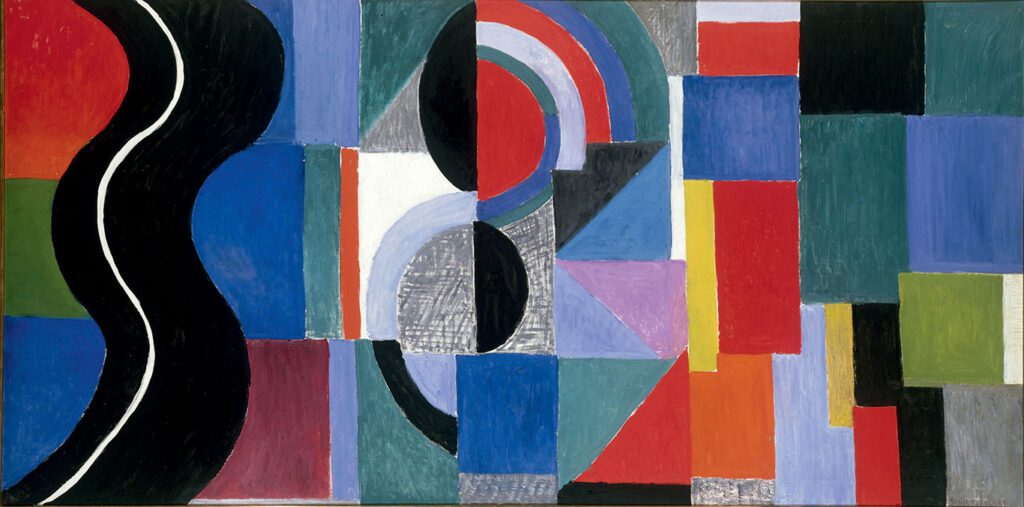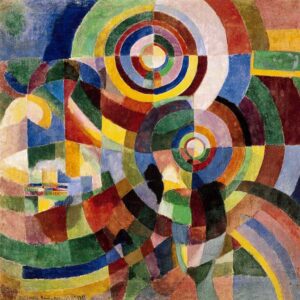

A towering unsung figure in the birth of early modernism, Sonia Delaunay and her husband developed early abstraction to remarkable maturity. Their aesthetic theory of simultaneity made abstraction plausible by focusing on pure colour and structure as the focus when looking at work.
For the Delaunays, the early 20th century required new forms to suite the new pallet developed over the last hundred years. Chemists had given the world a bold and brilliant new array of chroma which was found not just in paint, but in the manufactured world around – in signs, posters, objects, and the glass of coloured electric light. The Delaunays theory was about a way to capture this vibrant new world and the new ways of living that it emblemised. Simultaneous contrasts of colour create a rhythm and dance of movement and a disruptive pace of experience that was to capture the spirit of the age. Their aesthetic writing mirrors that of Maurice Merleau-ponty, who stressed two qualities of beauty that are everywhere in this show – radiance and rhythm. The design of Sonia’s paintings, fabrics, costumes and clothing are instantly recognisable to anyone familiar with 20th century abstraction. Concentric circles of radiating light are smashed into the syncopated rhythm of the new cities. Later, shattered mosaics of clashing colours resolve into cleaner minimalist patterns. An iconography of modernism will find all the tropes present here in chrysalis. Edgy nudes give way to cubist angles, later ticker tape minimalism in patterned fabric, then bold monumental geometric abstraction. What’s astounding though is how few duds there are. Sonia is good at everything – she dances freely from one discipline and style to another.
In the geometric work we see mysticism and monument to rival Kandinsky and Malevich, (it’s hard to see clearly who’s influencing who, but I would guess that Delaunay’s work is as often as not the original) the fabric patterns are timeless, and even the early Matisse and Gauguin pastiches are engaging.
The polished rhythm colour series stand out – a room of whirling circles and semi circles that phase the entrance the viewer like the Second World War ‘dazzle’ camouflage used to disorient rather than disguise. Here the world is blended in a brilliant vortex and just as enemy submarines would be unable to find a frame of reference so we lose our reference points as figurative painting finally succumbs completely to abstraction.
Early in the show is a blanket made for her infant son – this is the piece for which she is called ‘the mother of abstraction’ and is the best candidate for the first piece of abstract art. The quilt contains so much of later abstract work: A close inspection finds every asymmetric patch has been carefully established – the final effect is a fundament of 20th century abstraction: the irregular shapes are sewn together at once randomly and carefully chosen so that the hint of symmetrical pattern challenges the eye and leaves us mesmerised. The line between symmetry and asymmetry is followed like the hints of discord that disrupt the ease of early modern music.

A key to showing works of early modernism is often to effectively conjures the quasi-religious sense of artist as holy man – able to penetrate the mysteries of ‘significant form’ and the like. These shaman – ultimately snake oil salesmen used this fervent self belief to produce marvellous things – and Delaunay’s paintings at times have the bombast of early modernists declaring their theories and work as discoveries rather than creations. The notion of simultaneity is at once a typical modernist aesthetic, with platonesque aspiration to uniquely penetrate the nature of ‘significant form’, yet for Delaunay simultaneity was a transient model, one suited particularly to the new age, which described the pace, dazzle, and transfixing quality of electric light and automated machines. The idea seems to have been impressionistic – to capture a shared experience but not one universal, rather one that is momentary and particular.
The modernist’s optimism is lighter than many of her peers. The Delaunays claimed that we have ‘triumphed over the sun’. But this is more about having the glow to dance the night away than the orphic destiny or a brave new political and social landscape. And so whereas Malevich’s triumphalism about the new soviet future gave way to the terrible remorse and searing despair of a man who put his name to evil, Delaunay has no great folly to forgive. That’s not to say the work is thoughtless or flippant – it’s not all airy jubilance. There is just a hint of the modern world’s fearful vertigo in the half moon geometric paintings and the Yellow Nude sits in the glare of a new age that is not all progress and liberation.

For some it may be gauling that while Picasso was hanging ‘Guernica’, Delaunay was painting ‘Tango Dancers’. And while the work isn’t obviously politically engaged, it would be pompous to argue that it is absurd or naive or irresponsible to do joyful painting during the First World War. The notion of the artist as architect of history and the claim that art is always political, doesn’t possess Delaunay in the same way as her peers. The need to be the centre of things doesn’t seem to have troubled Delaunay yet she clearly was.
The overwhelming sense though, is of a ‘proper’ painter, one who paints all day, carries a room, and was an uncontrived architect of her world’s visual landscape. Therefore the feminist angle to the exhibition is very much on point. There is no hint of feeble, one dimensional political work here, buoyed by excess essay. While the catalogue does have an impassioned and strong critique of the culture that excluded Delaunay, argument is really superfluous. That the body of work carries room after room of rich and engaging, and more often than not prototypical work, is searing enough indictment: clearly Sonia has been done an injustice by the art world men’s club and deserved this show a long time ago.
Frank Corrigan
The EY Exhibition: Sonia Delaunay Tate Modern: Exhibition 15 April – 9 August 2015
Volume 30 number 1, August / September 2015 pp 36-37

